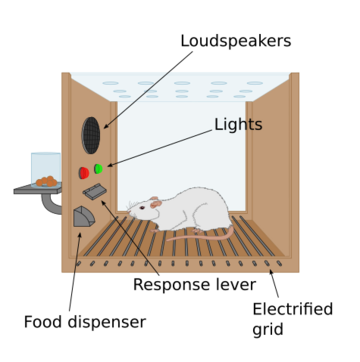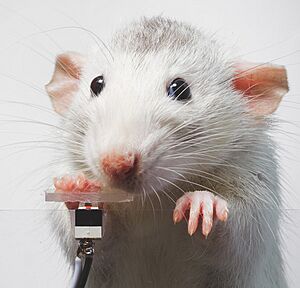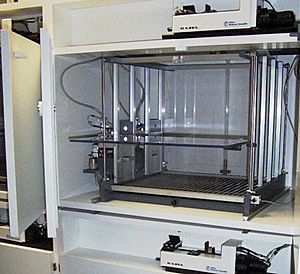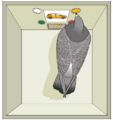Operant conditioning chamber facts for kids
An operant conditioning chamber is a special box used by scientists to study how animals learn. It's also known as a Skinner box, named after B. F. Skinner. He was a scientist who created this box while studying at Harvard University.
This chamber helps scientists understand how animals learn new things. Animals like rats or pigeons are placed inside. They learn to do certain actions, like pressing a lever or pecking a button. If they do the right action, they get a reward, like food. Sometimes, the box can also remove something unpleasant, like a loud noise. This helps scientists test their ideas about how learning works in a controlled way.
Contents
What's in a Name?
B. F. Skinner wasn't a big fan of the box being called a "Skinner box." He didn't like having his name used for it. People think that another scientist, Clark L. Hull, and his students at Yale University came up with the name. Skinner even asked someone to use "lever box" instead of "Skinner box" in a document.
How It Started
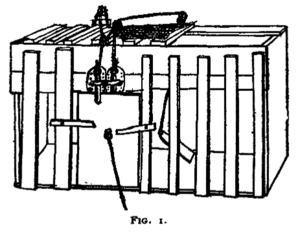
Back in 1898, a scientist named Edward Thorndike came up with an idea called the 'law of effect'. This idea is a big part of how we understand learning today. Thorndike studied how cats learned to escape from special "puzzle boxes." The cats were trapped until they pushed a lever or did something else to open the door.
Thorndike watched how long it took the cats to escape. He noticed that the cats learned by trying different things until something worked. They learned that their actions had a result. If the result was good (like escaping), they were more likely to repeat that action.
B. F. Skinner built on Thorndike's ideas. Skinner added that if an action leads to a reward, it's more likely to happen again. But if an action leads to something bad, it's less likely to happen again. He called the rewards "reinforcement." Skinner's work helped us understand how animals learn through rewards and punishments. He designed the operant conditioning chamber to watch animals in a very controlled way. This made it easier to study their behavior without surprises from the outside world.
Why Use These Chambers?
Operant conditioning chambers let scientists study how animals learn and react to different situations. They teach an animal to do specific actions, like pressing a lever. When the animal does the right action, it gets a reward, like food. This is called positive reinforcement.
Sometimes, the chamber might give a small punishment to stop wrong actions. For example, scientists used a "heat box" to study how some small creatures react. One side of the box could get warmer. When the creature went to the warm side, the temperature would go up. Soon, the creature learned to stay on the cooler side. Even when the temperature was turned down, it would still avoid the side that used to get hot.
Skinner also studied pigeons. He used levers that would give the pigeons food when pressed. Scientists made these studies more complex to learn about how animals learn from each other. One pigeon would learn to press the lever for food while another pigeon watched through a clear wall. Then, they would switch the pigeons to see if the watching pigeon had learned by observing.
What's Inside the Box?
An operant conditioning chamber is a large box, big enough for the animal inside. Common animals used are lab rats, pigeons, and sometimes even primates. The box is often soundproof and lightproof. This stops outside noises or lights from distracting the animal.
Inside, there's at least one way for the animal to respond. This could be a lever for rats or primates to press. For birds, it might be a button they peck. When the animal makes the right response, a computer records it. The box also has a way to give a reward, usually food.
Simple boxes with one lever and one food dispenser can teach us a lot. But modern chambers can be much more complex. They might have several levers, different food dispensers, and many ways to create stimuli. These stimuli can be lights, sounds, music, or even pictures on an LCD screen. Some boxes even have special floors that can give small shocks as a punishment, or lights that tell the animal when food is ready.
How This Research Helps Us
Operant conditioning chambers are very important in studying how animals learn. They allow scientists to watch animals closely and change things in their environment. This controlled setting helps with research that might be hard to do in the wild.
The ideas from operant conditioning have many uses. For example, how a child learns is shaped by compliments, comments, and approval from others. When a child achieves something, like crawling, parents often praise them. This praise makes the child more likely to do that action again. If a child misbehaves, parents might use verbal warnings or take away privileges. This helps discourage the child from repeating the bad behavior.
Skinner's studies on animals helped scientists understand how humans learn too. Based on his work, scientists learned about the effects of positive and negative reinforcement on children. Skinner showed that our surroundings affect our behavior. If we change the surroundings, behavior can change too. This research has been used in education and in helping young children with certain challenges. Skinner's ideas helped psychologists understand why rewards are so effective in learning.
Real-World Uses
You might not realize it, but ideas from operant conditioning are used in many things we see every day. Think about Slot machines, online games, and even dating apps. These often use clever reward systems to encourage you to keep playing or using them.
The idea of Gamification also uses operant conditioning. This is when game-like elements are added to non-game activities. It's used to encourage people to do certain things, like completing tasks or learning new skills.
See also
- Behaviorism
- Radical behaviorism
- Operant conditioning
- Punishment (psychology)
- Reinforcement
- Synchronicity
Images for kids


